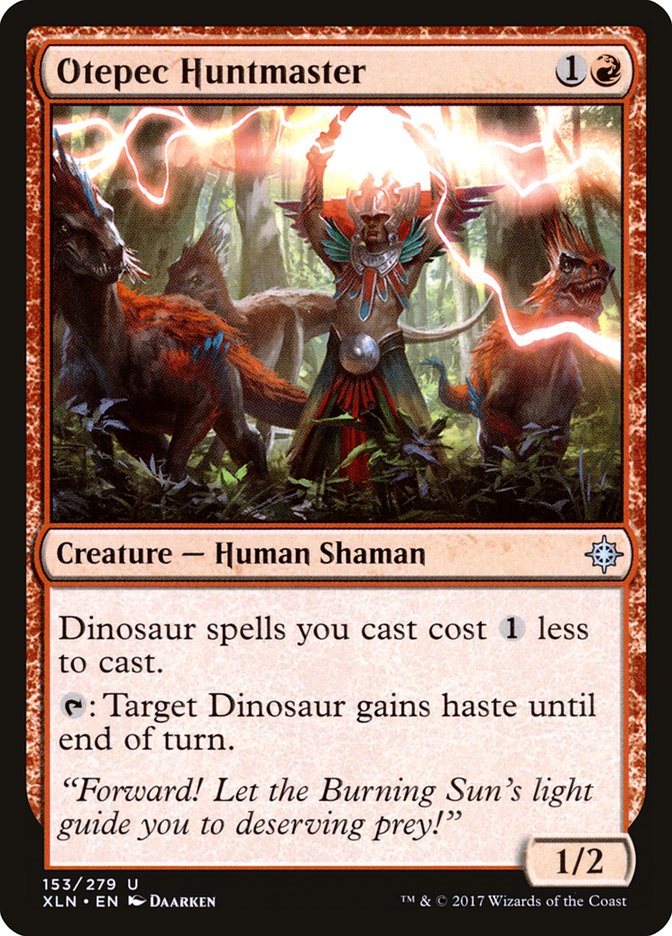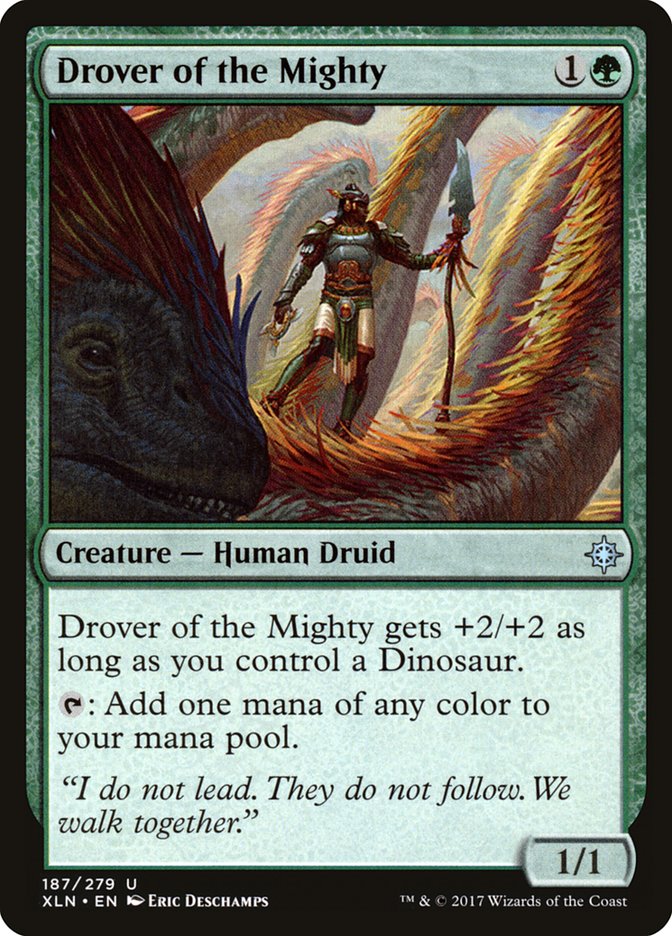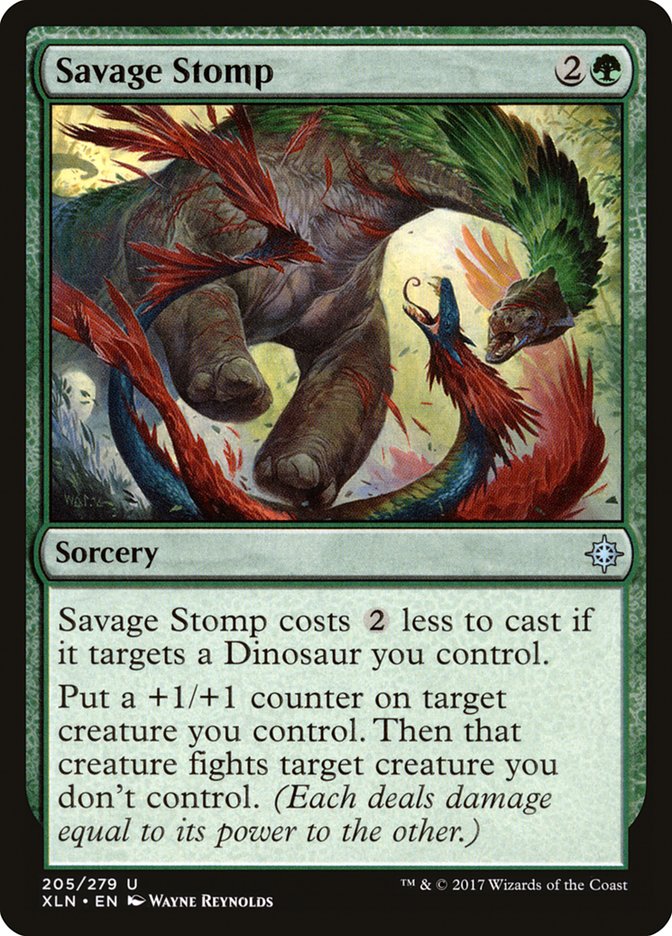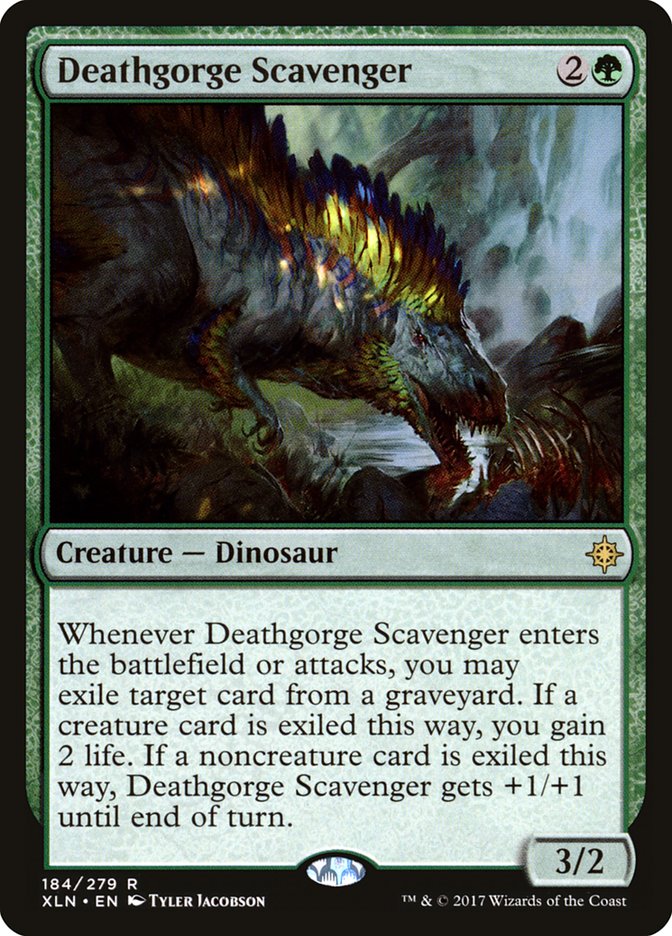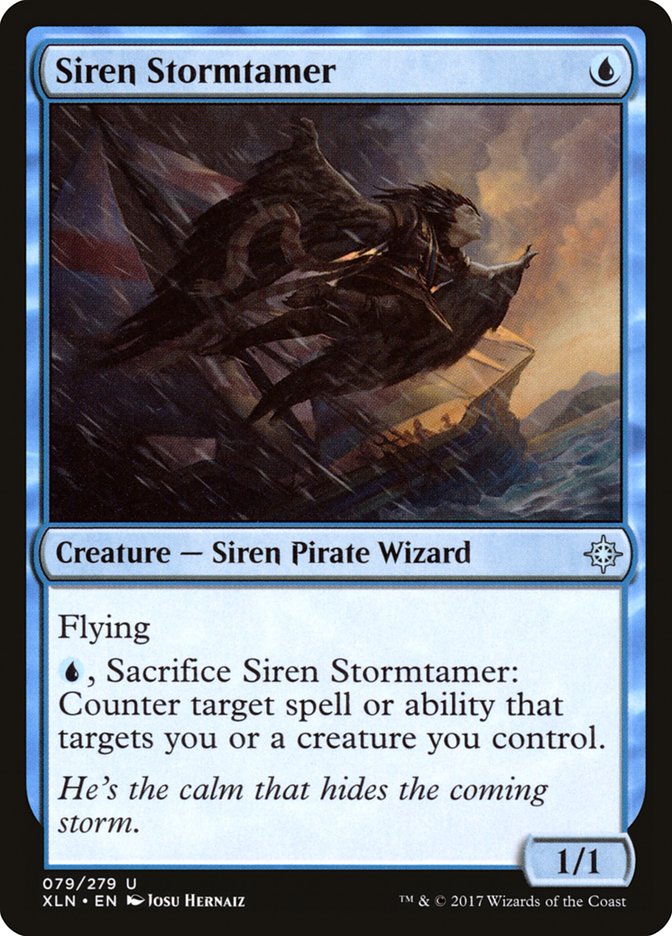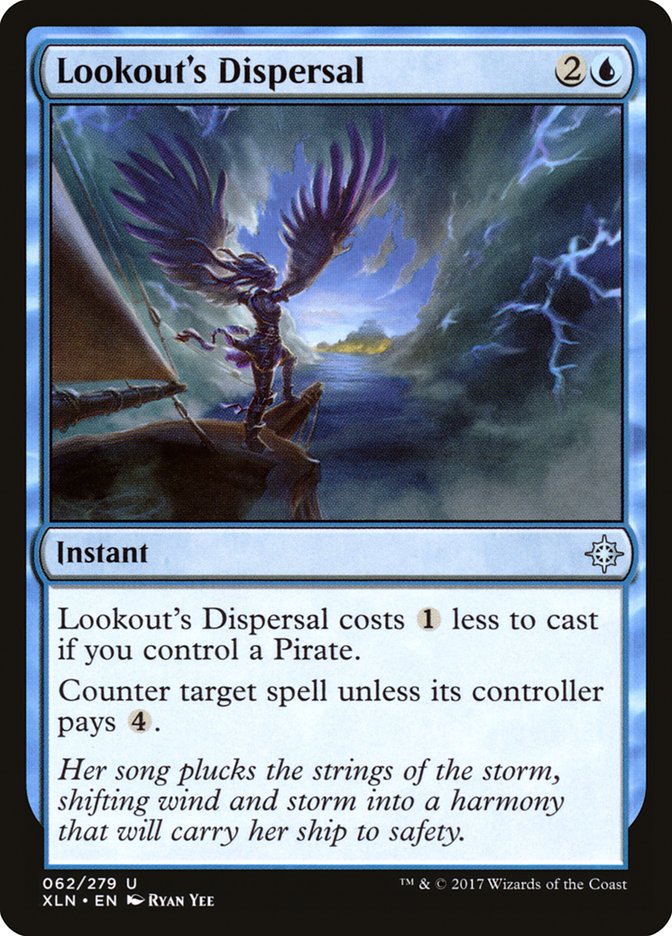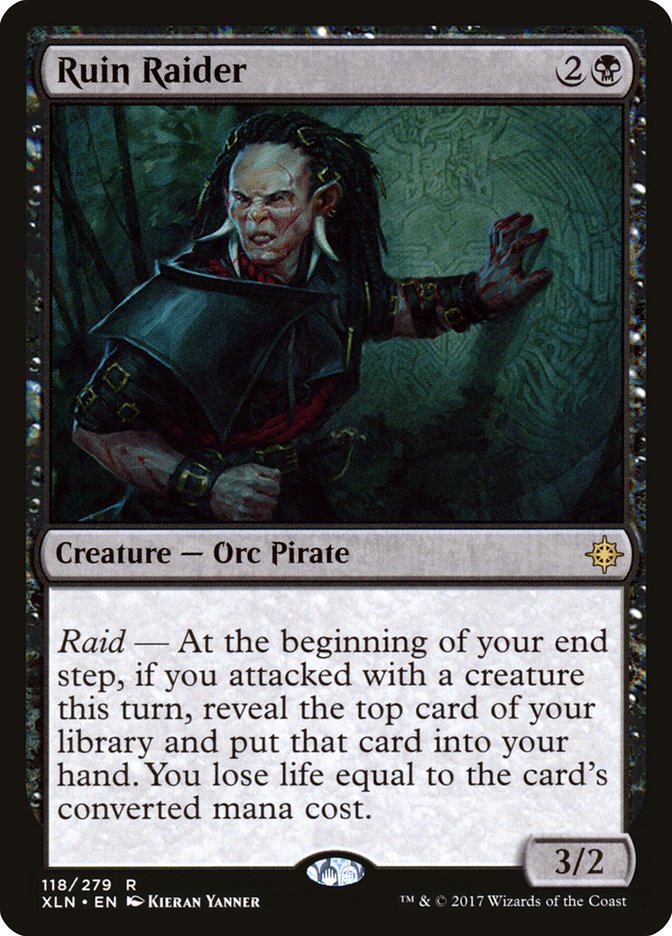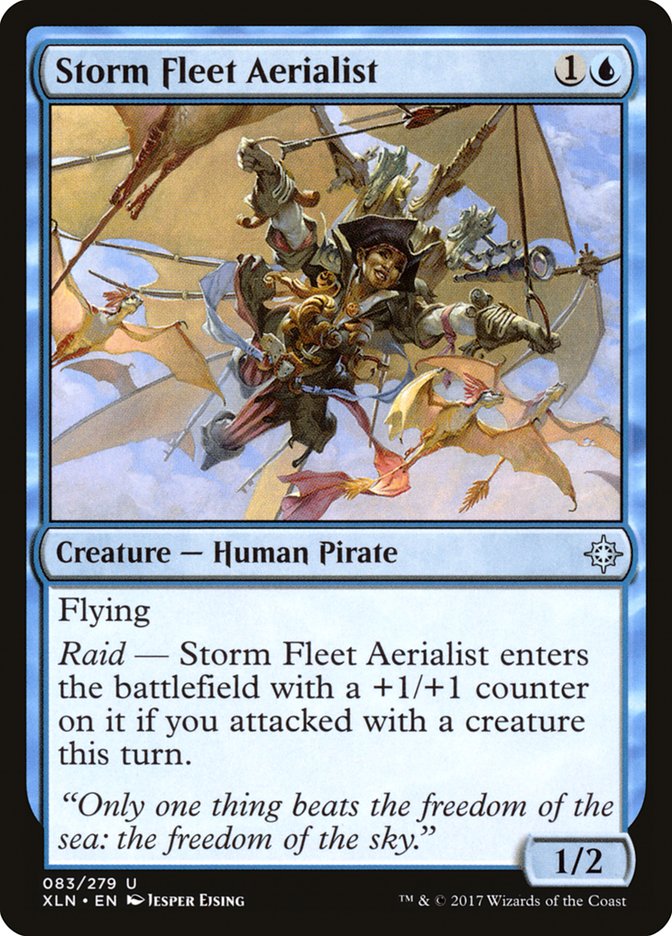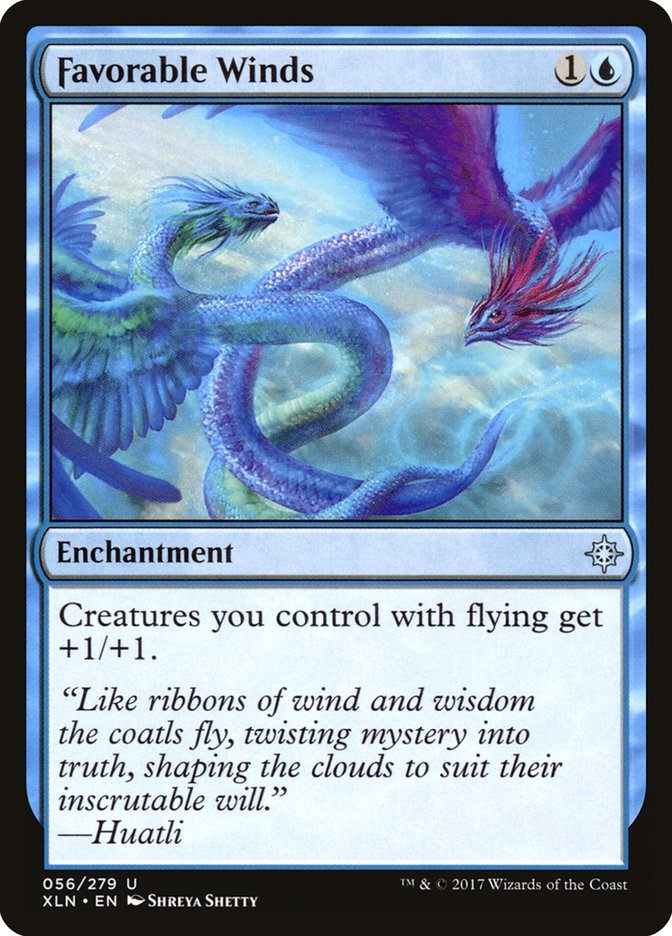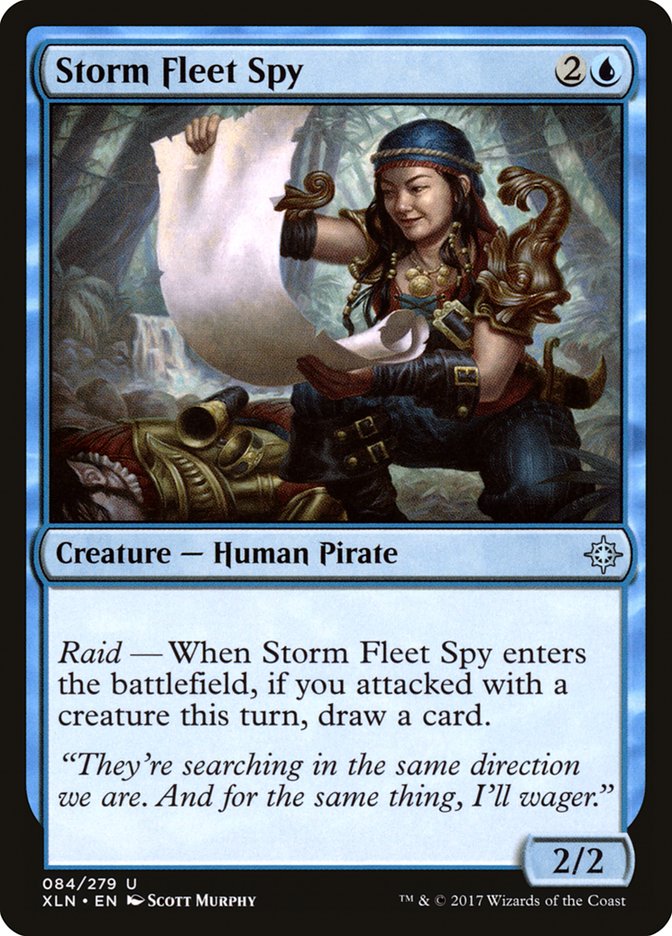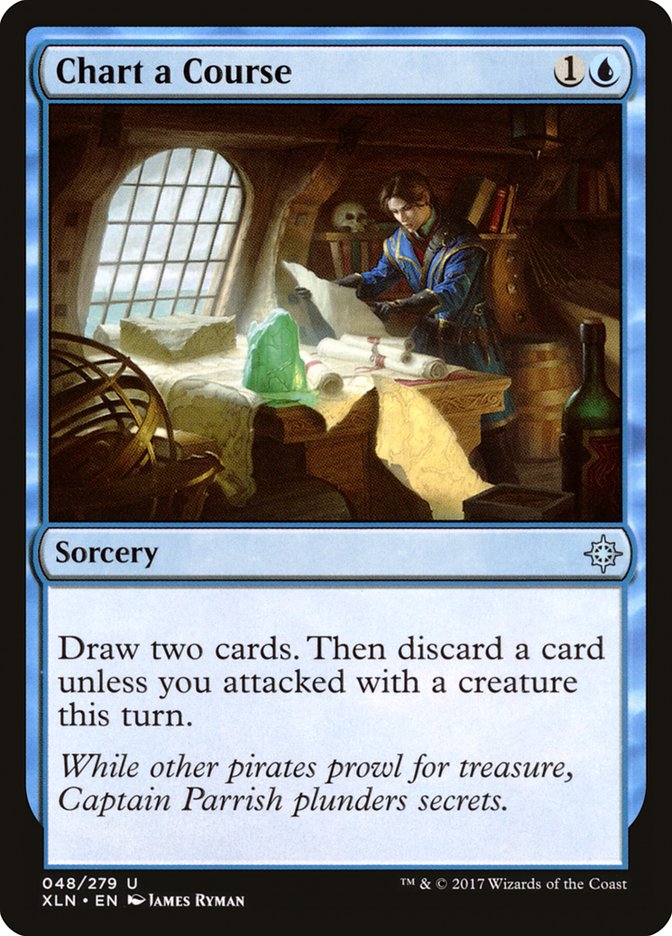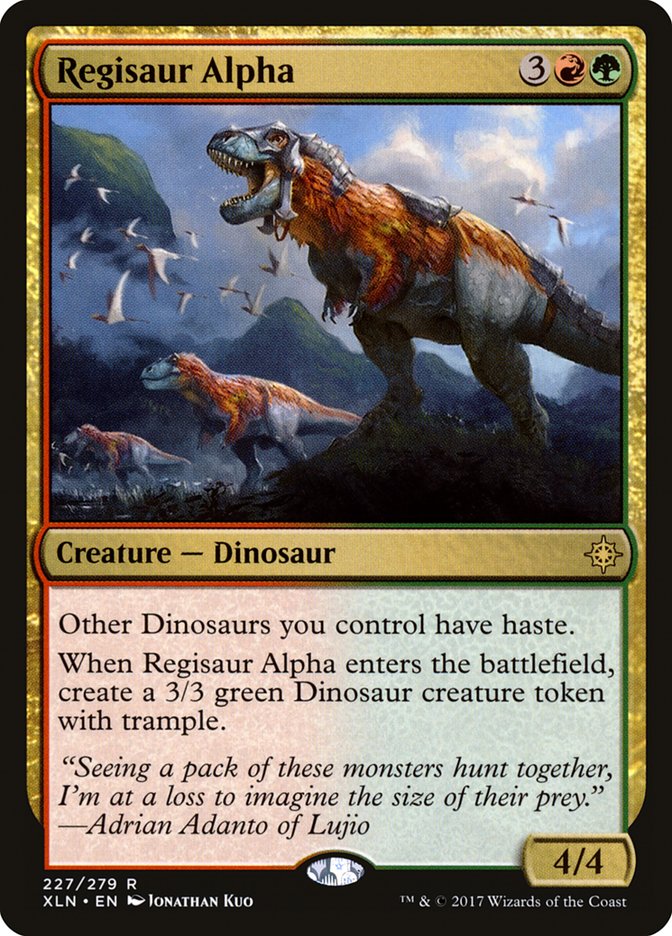Now that we have the entire set of Ixalan at our disposal, the brewing can commence. New decks are sure to come out of the woodwork, as this set features some very interesting build-around cards. On top of that, the tribal synergy is there, and we just have to put the right pieces together.
Dino-Mite
As I wrote about last time, some of the colors are bleeding into each other as far as tribal is concerned. Picking the right support spells might be difficult, but the real test will be to see if any of the new tribal decks can beat a Whirler Virtuoso. The only deck I’ve seen so far that could overcome such an efficient card is Dinosaurs, which makes it the top tribal deck for me.
If you check out the VS video from yesterday, you’ll see Tom Ross beating me to death with giant lizards, and that’s not something I’ve seen in quite some time (the “large monster” part, not the “me losing” part). Sure, Energy decks often run Dragons and Hydras, as well as other powerful midrange threats that can swing games in your favor. But that seems to pale in comparison to Carnage Tyrant. While not particularly overwhelming on its own, Carnage Tyrant promises to close out games quickly. Control decks will have a difficult time with it, and even some aggressive decks might not be able to race it.
That seems like an odd sentence, right? Why would an aggressive deck have trouble with a six-mana creature that doesn’t immediately impact the board in a big way? Well, for starters, the early threats in the Dinosaur deck are actually fine cards against aggressive opponents. Let’s take a look.
Otepec Huntmaster seems relatively harmless at first, but once you realize how powerful the 1/2 becomes when you don’t kill it, things start to get dangerous. Just imagine curving Otepec Huntmaster into Ripjaw Raptor into virtually any other threat. Without a sweeper effect like Fumigate, this draw will be very tough to beat. Dinosaurs tend to be larger than most other creatures in power/toughness, and they only get harder to beat when each one you cast has haste.
I started playing Constructed Magic right around the time Fires of Yavimaya was printed. I remember pairing it with the likes of Saproling Burst and Blastoderm to get in huge chunks of damage from tough-to-kill permanents. While the Dinosaurs in Ixalan might not be on this same power level, imagine if Fires of Yavimaya also made your creatures cost one less mana.
I know that a 1/2 body might not be that hard to clear. After all, virtually every removal spell in the format can kill it, and most decks will have access to some number of removal spells to deal with creatures. That’s just how Standard works. But imagine if every opponent is forced to choose between killing your 4/5 or your 1/2 creature. Dinosaurs, like most creature-based decks before it, usually does a great job of overloading your opponent’s removal spells. And if your two-drop creature requires a removal spell for fear of overwhelming the opponent, then I think we’ve hit the jackpot.
It is rare that a mana accelerator becomes a reasonable threat as the game progresses. If you’re curving out naturally and don’t actually need the extra mana, then Drover of the Might can start attacking on the third turn for large chunks of damage. Additionally, Drover of the Mighty allows for the lopsided draw of a three-drop Dinosaur plus Savage Stomp. And if you don’t think Savage Stomp is the real deal, I’ve got some bad news for you.
Is this card just Prey Upon with some pizazz? Maybe, but I also think that cards that say “fight” are wildly underrated. In the current Standard format, it is rare for your opponent to never tap out on their own turn. And when they do, Savage Stomp becomes a huge tempo boost. The +1/+1 counter is a big deal on cards like Carnage Tyrant, but the fight ability is also pretty sweet with Ripjaw Raptor.
While Savage Stomp won’t be winning any awards for best removal spell in the format, I do think it deserves to see some play. The Dinosaurs are just bigger, on average, than the rest of the creatures in Standard. And for only one mana, Savage Stomp is one heck of a deal.
I wanted to take a moment to look at this card and see just how good or bad it might be in a Dinosaur deck. Since it came out at the last minute, not a lot of people have had a chance to talk about it, but I think it deserves some recognition.
What Deathgorge Scavenger brings to the table is a fluid way to interact with graveyards, gain life, and generate a solid battlefield presence. While it can’t add mana to your mana pool, all those other abilities make it sound a lot like Deathrite Shaman. Of course, this card isn’t Deathrite Shaman, but instead it acts a lot like a Kitchen Finks that consistently exiles cards from your opponent’s graveyard. For three mana, that’s quite a lot of text.
Now, you might say that Deathgorge Scavenger could enter the battlefield when there are no cards in any graveyard, and you’d be right. But what about the turn it attacks? Surely you can find a Savage Stomp or something to take care of your opponent’s blocker, which in turn allows Deathgorge Scavenger to attack for four points of damage while gaining two life. Against an aggressive strategy, that’s quite a lot of upside for a paltry three-mana investment. And if you’re playing against a graveyard-based strategy like God-Pharaoh’s Gift, a single Deathgorge Scavenger can give them nightmares if left unchecked.
Gerry Thompson wrote a great article about this archetype already, so I won’t harp on it too much longer. Just know that this is the version of Dinosaurs that I think will be the best for Week 1 of Ixalan Standard at #SCGDFW.
Creatures (22)
- 2 Carnage Tyrant
- 4 Regisaur Alpha
- 4 Ripjaw Raptor
- 4 Drover of the Mighty
- 4 Otepec Huntmaster
- 4 Deathgorge Scavenger
Planeswalkers (2)
Lands (8)
Spells (28)

No frills. No bells or whistles. And certainly no Walking Ballista. Ripjaw Raptor is good enough without it, and I don’t want to be playing Ranging Raptors in my deck. Once you understand what’s most important in the Dinosaur deck, you’ll know exactly what I’m talking about.
Yarrgh, Pirates!
Pirates is another hotly debated archetype in the new Standard format. Unlike Dinosaurs, they have a lot of trouble beating up on the existing archetypes. Not only can they have a tough time against Whirler Virtuoso, but they’re also fairly vulnerable to an opposing Walking Ballista. Many of the early threats are one-toughness creatures, and none of your draws will match up well against an unfettered Winding Constrictor plus Walking Ballista. Obviously, you have removal in the form of Fatal Push and such, but failing to draw it in the early turns of the game will result in you getting run over.
But it is possible we’re building the Pirate deck all wrong. Blinded by Fathom Fleet Captain and Ruin Raider, we’re playing a two-color aggressive deck that might not even be playing the right secondary color. So far, I’ve been very impressed with Ruin Raider, but Fathom Fleet Captain has definitely left something to be desired. Making creatures for two mana while attacking with a menace creature feels sweet, but I don’t know if it is remotely good enough. This is truer in versions that are trying to play counterspells like Lookout’s Dispersal, as you don’t really want to spend mana on your own turn if you can help it.
What cards I do want to focus on are as follows:
After playing just a few games with this card, I can already tell I’m going to love it. Obviously, it doesn’t have the punch of Delver of Secrets, but the ability to protect your more important creatures as the game goes late is impressive for such a small investment. The chip damage is a bonus, but the ability to turn on Raid with ease is not to be taken lightly.
While it is a bit mana-intensive to continually hold up a mana to protect your other creatures, you will find yourself in a lot of situations where you just want to curve out. In those scenarios, you should be able to leverage the protection ability of Siren Stormcaller on the fourth or fifth turn rather easily, as your opponent will be more focused on killing your more important creatures.
This is another card I was really impressed with in the first few games of testing. Not only did it allow me to easily counter cards like Glorybringer, it also provided me with a buffer against sweeper effects, planeswalkers, and a number of other tough-to-beat spells. I can only imagine how good it will be against decks reliant on resolving Torrential Gearhulk.
While Lookout’s Dispersal doesn’t seem exciting on paper, once you get into the games, it becomes much more apparent how powerful it actually is. Mana Leak has always been a stellar card when it was in Standard, and the same can be said for those like it (Rune Snag). While it will cost three mana on occasion, those are usually the games where you’re losing and/or significantly far behind. But even then, stopping their big threat and then resolving one of your own is nothing to scoff at.
While the U/B Pirates deck might be the best home for this card right now, I think there might be a solid Mono-Blue Skies deck revolving around Favorable Winds. While not all of your creatures will be Pirates, I think somewhere around eight to twelve Pirate creatures should be sufficient. But again, you don’t actually need a Pirate on the battlefield to make this card viable. It is still plenty fine without the cost reduction aspect.
If we continue to be in blue and black, Ruin Raider is an obvious inclusion. The extra cards drawn from Ruin Raider help generate a ridiculous amount of tempo, and any draw from the opponent that can’t kill it will usually result in it running away with the game. While black might not be the best secondary color for Pirates (and we might not even want another color besides blue), Ruin Raider has already proven, to me, that it is worth the investment. The card does some serious work.
The downside of losing life is obviously not free, but I do think that you can build your deck in such a way that it doesn’t hurt you very much. Even against aggressive decks, the extra cards should be worth more than the life lost if you do your best at trading creatures at key points.
While I don’t think this deck is good enough just yet (but could be with the right build), here is the version I’m set on testing for the next week.
Creatures (20)
Planeswalkers (2)
Lands (24)
Spells (14)
Sideboard

While this deck is fairly low on raw power, the cards all work together in some interesting ways. You can gain a huge tempo advantage in the early turns with cards like Fatal Push and Unsummon, which put a lot of pressure on your opponent to answer creatures like Ruin Raider. While Hostage Taker is not exactly a phenomenal creature, it does give you some added kick in the later turns of the game. Effectively stealing an opposing threat is huge, and you can protect it with Siren Stormtamer if you hit five mana.
The games you lose will almost always be because you got outclassed when it came to power level. But to be honest, that’s the nature of decks like this. We’re all-in on synergy, so our plan starts to fall apart once our opponent puts a brick wall in front of us or kills all of our creatures. If you want to play Pirates, there’s not really a whole lot you can do about that.
You might have noticed a lack of Walk the Plank. Personally, I’m not sold that the card is actually good. Sorcery-speed removal is a bit lackluster, but it is hard to argue with efficiency. For now, I’m going to be trying out Vraska’s Contempt in that slot to see how I like it, though I expect the four-mana price tag to be a bit much.
Cards to Watch
While not exactly ground-breaking, Storm Fleet Aerialist has solid stats. If you can lead the game off with another flying creature, you should be able to curve into this nicely. And if you do decide to go the route of Favorable Winds, then Storm Fleet Aerialist is a no-brainer.
The first time this card was in Standard, it was alongside Lingering Souls and still didn’t see very much play. To be fair, that was mostly due to the fact that Intangible Virtue was just a significantly better card. But this time around, we have quite a few cheap creatures that could make Favorable Winds into a legitimate strategy.
All credit here goes to Ross Merriam (unless he stole the deck from someone else).
Creatures (19)
- 4 Hope of Ghirapur
- 3 Nimble Obstructionist
- 4 Dreamcaller Siren
- 4 Siren Stormtamer
- 4 Storm Fleet Aerialist
Lands (22)
Spells (19)

In the past, creatures that draw a card when they enter the battlefield get a bit of attention, but only if the other cards around it can leverage that extra card advantage. While this doesn’t seem to fit in either the U/B Pirates deck or Favorable Winds deck, I could see it finding a home in a different sort of Pirates deck (though it being a Pirate doesn’t actually matter all that much). Like Ruin Raider, it doesn’t really need the Pirate theme to function, just creatures that will attack.
While a lot of decklists I’ve seen lean toward this card in aggressive Blue decks, I don’t actually know how good it is. If you’re trying to attack in the early turns, it only seems right that you should be focused on adding more threats to the battlefield. Drawing cards is fine and all, but I don’t really understand the appeal of this card. I could be flat-out wrong, though, and I’m willing to admit when I am wrong about something, but it just doesn’t feel like it fits!
The Week 1 Dream
Over the next few weeks, we’re going to be seeing a lot of Ixalan Standard. The set offers a host of unique cards that are virtually impossible to understand until we physically get our hands on the set. For example, I think most of cards that flip into sweet lands are actually ridiculous, but I have no idea how to build a deck with them.
They’re complex, and perhaps a little too complex to really find a home. And that’s a shame, because all of them seem like really awesome designs, in both flavor and ability. But while those cards are going to be hard to evaluate, I expect a few of them will show up in the first few weeks in makeshift versions of what are sure to become some of the best decks in Standard. I could see Jim Davis bringing Search for Azcanta to the table. I could see Tom Ross trying to flip Vance’s Blasting Cannons. I could even see Ross Merriam flip the table when he loses to Abrade while trying to flip Primal Amulet (and me too, I guess).
Regardless, this set looks like it’s going to be a lot of fun in both Limited and Constructed. I just hope that Kaladesh and Amonkhet don’t overshadow it too much. While I’m sure we’ll see our fair share of Winding Constrictor and Glorybringer, I really hope I get to see someone beat the absolute snot out of someone else with a Regisaur Alpha. The fifteen year-old inside me would be so happy.
Rawr!


